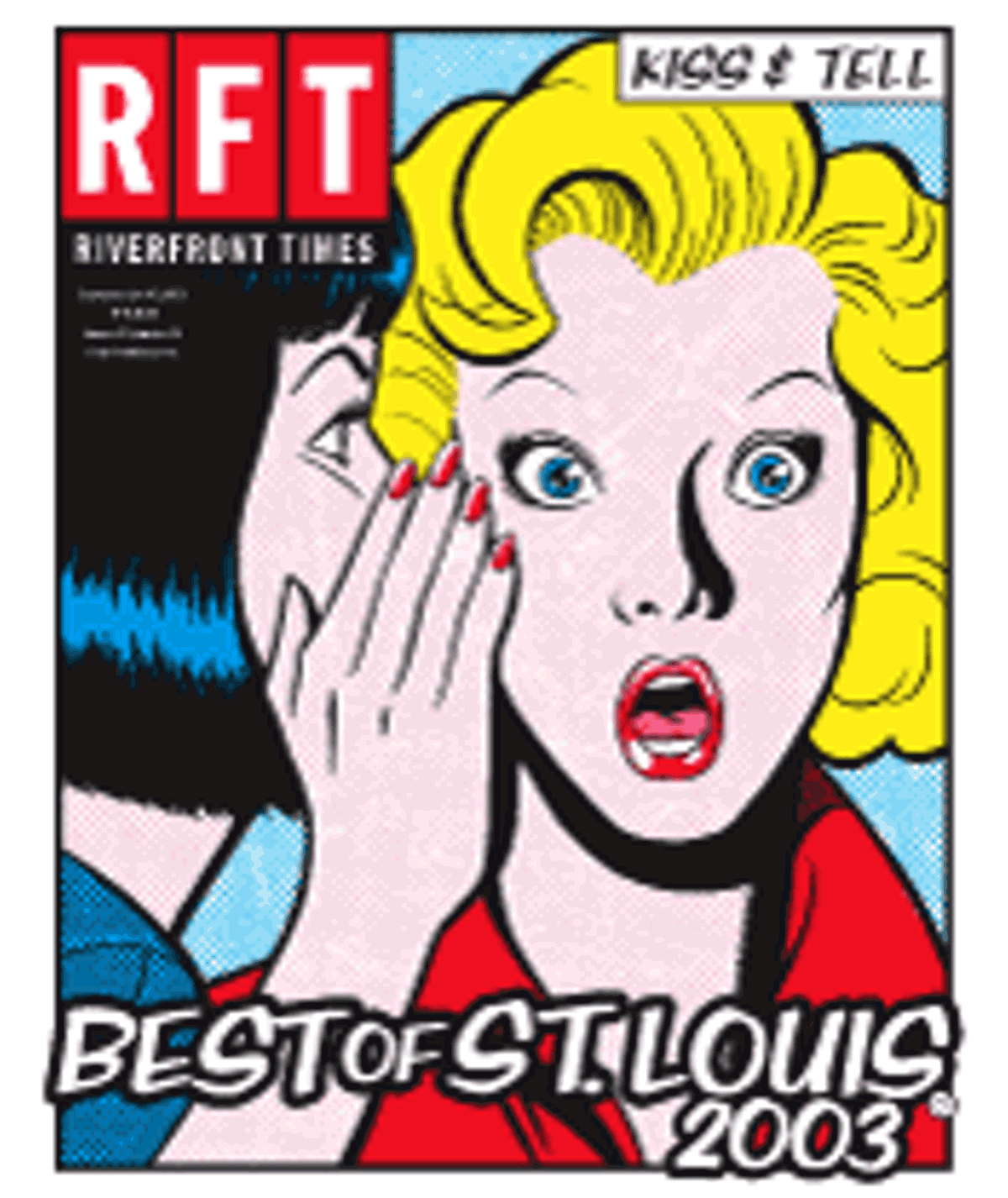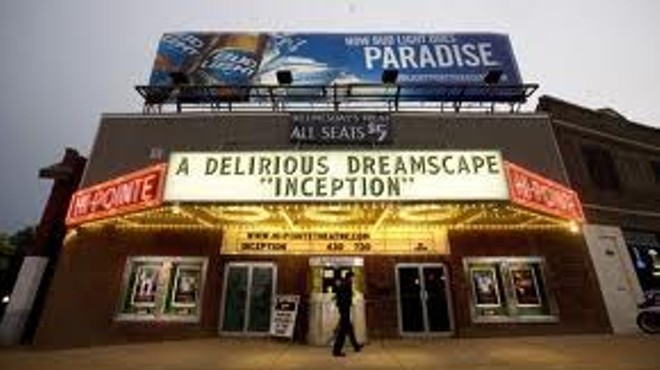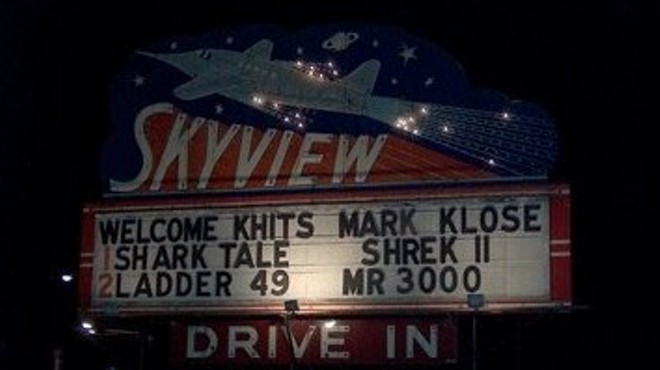The choices for best hair on a male TV personality range from balding to bald to helmet. It is tough to find long hair -- much less a ponytail, mullet or mohawk -- in this ultraconservative news-reader crowd. This year's award goes to KSDK Channel 5's Art Holliday, the newscaster with the boy-next-door appeal and receding hairline. Holliday co-hosts Today St. Louis with Jennifer Blome; given that the show goes on the air when most people are rolling out of bed, he should be thankful he doesn't have much of a mane to tame. That may explain why he always looks so bright-eyed and chipper at 6 a.m.
The members of Grand Ulena have garnered notoriety for their pedigree, their simultaneous refusal to play their hometown while declaring themselves "Ambassadors of St. Louis" and the St. Louis Police Department's recent "courtesy call" on their practice space. All this controversy, both imagined and real, has almost overshadowed Grand Ulena's finest achievement: Gateway to Dignity, their début, is the album the St. Louis music scene deserved. A brutal, carefully orchestrated assault, Gateway to Dignity screams "We are of you," without ever claiming "We are with you." It is a singular statement, both a declaration of solidarity and of independence, a uniquely St. Louis album that pays homage to our ancestral bonhomie and rejects our "Where'd you go to high school?" parochialism. This dichotomy is the source of Grand Ulena's claustrophobic, wide-open power: Let go of St. Louis and then embrace St. Louis, they say. See it again with new eyes; hear it with new ears; feel it with a new soul. Gateway to Dignity is a new beginning, a point of departure for a new generation of music. This is the rebirth of the cool.
Picking a winner in this category is like selecting an entrée at Applebee's: Everything's designed to appeal to the widest possible audience, so it all tastes pretty much the same, nothing too bold or spicy. This year's winner, Vickie Newton, has a hairstyle -- best described as straightened, with a "kick" at the end -- that manages to do all that and much more. You can catch the former CNN Headline News anchor -- and her elegant, flattering and professional hair -- every weeknight at 5, 6, and 10 p.m., when she anchors the evening news with Larry Conners.
Like there's any question here. This summer you couldn't hide from Chingy's début single, "Right Thurr," even if you wanted to. But why would you want to? What kind of person didn't fall for the song back in the spring, when it was bubbling on local radio before exploding everywhere as the inescapable hit single of the summer, 2003 edition? Somebody who doesn't own a radio or somebody who doesn't like fun, that's who. The combination of a devastating pop hook and a down-and-Dirty South beat (plus gratuitous use of that alternately endearing and irritating St. Lou drawl) may be a formula after Nelly's success, but damned if it isn't a winning formula -- and one that Chingy and the Track Starz production team imprinted all over the brains of radio listeners this summer.
On June 7, 2003, the Flaming Lips cured cancer. Really. Every person in the audience that night felt it happen; the bitterness and pain and regret and recriminations that gnaw at your insides and leave you with a bellyful of dead black sludge were burned away by the incandescent joy of the Flaming Lips. Wayne Coyne, resplendent in white suit and oversized plastic Hulk fists, sang to us and for us, offering hope and encouragement, along with costumed animals, heart-shaped balloons and the sort of compassionate leadership we didn't know we were hungry for. When a girl in the audience asked Wayne if he would be her father figure, Wayne paused. "You mean like, be a role model?" he asked. "Someone to show you how to live, and offer advice? OK, yeah. Yeah, I will." The crowd erupted in cheers as the Lips embarked on another one of their gorgeous pop songs, and we were healed. Life was beautiful, we were a family and Daddy was going to sing us to sleep.
What the St. Louis cinema scene lacks in screen volume, it makes up for with character. The luxury of the Chase, the ornate majesty and scheduling ingenuity of the Tivoli, the stridently highfalutin art-house standards of Plaza Frontenac, the seamless milieu of old and new at the Esquire -- there is considerable virtue to behold and accolades to bestow around town. But none parallels the icy cool splendor of the 81-year-old Hi-Pointe Theatre. Basking in a blue glow of minimalist chic that extends from its lone screen to the meticulous urinals of the little cowboy's room upstairs, the Hi-Pointe doesn't overplay its cinematic hand. It just plays the hand it's dealt to the highest possible standards, providing a cinematic experience that comes as close as any other to meriting the inflated price of popcorn these days. And it certainly doesn't hurt that there's a charmingly shabby bar bearing the same name next door for the post-flick brain dump.
Malade de Souci may or may not exist: Few people have seen them play, fewer still know who they are and no one seems to know anyone who might actually be in the band, assuming the band exists. We're not saying they do: We are simply acknowledging that the two albums of non-Euclidian, noodly sauerkraut-from-space-rock that are attributed to them are pretty entertaining, and we're also noting that the name Malade de Souci is the best band name since, oh, let's say Goober and the Peas. Somewhat sinister, somewhat goofy, the moniker imparts no sense of who they are or what they sound like. "Veddy mysterious," intones Professor von Rock Critic. "Yowie!" yelps his lab assistant as the music starts. There's much to be said for the sneak attack, but let's not speak of it here.
Once a monolith rising from the open fields of the river bottom, the Skyview Drive-In now competes with the strip malls, fast food and the hectic traffic of North Belt West in Belleville. Opened in the summer of 1949, the Skyview was state of the art -- even expanding, like a dinosaur sprouting freakish wings, to Cinemascope dimensions -- until a tornado ripped those wings off in 1955. Twenty-six years later another wind storm all but razed the pink structure. The drive-in rose again, this time with two screens, now showing double features on summer nights. The look and feel of a '50s drive-in remains: The rocket-ship marquee announces titles like Matrix: Reloaded and American Wedding, kids hit the swings on the simple playground, and teenagers hustle corn dogs and lemonade at the snack shop. The sound system has abandoned the window-mount speakers and now transmits via radio waves; bring lounge chairs and a portable radio and you can sit under the stars and sink into the dream that only movies -- gigantic and irresistible as the horizon -- inspire.
Cinema St. Louis, the organization formerly known as SLIFF, has grown in many directions over the past few years, the best of which showcases the filmmaking talents of homegrown auteurs. The St. Louis Filmmakers Showcase celebrated its third anniversary in 2003, hosting the talents of more than 65 local artists and entertaining some 2,200 viewers over the course of five days in June -- including one crowd of 700-plus for the premiere of Chris Grega's Amphetamine. The best twenty films were selected to screen again in the film festival in November: much-deserved exposure. Through its special events and forums, Cinema St. Louis promotes film "as an art form," providing opportunities to see works that would otherwise never see light in St. Louis' corporate-owned theaters.
There isn't a lot of money to be made on the local rock scene if you're a musician -- Clear Channel sees to that; hence the merch table that appears at nearly every show. Local bands attempt to financially justify getting the night off from work to play the show by selling logoed and branded shirts, hats, CD-R's, singles, tape comps, live videos, anything at all that brings in more money than it costs to make or buy wholesale. Some bands are better than others at merchandising themselves, but when it comes to laying out an enticing array of self-promotional paraphernalia, the Conformists are the acknowledged masters of the art. In addition to keeping all the aforementioned items in stock, the Conformists have, at various shows, attempted to sell rocks with "Conformists" hand-lettered in magic marker on them, shards of metal with the distinctive Conformist Kitties sticker slapped on them and a plastic ashtray that someone left on the merch table while they were sizing T-shirts. Art statement? Fugazi-esque commentary on the commercialization of youth culture? Desperate attempt to separate drunken showgoers from their cash? Who knows? A Conformist rock is no stupider than a Dead Celebrities T-shirt.








